Analysis of Australian Welfare Systems and Services for Mental Health
VerifiedAdded on 2023/05/30
|8
|1704
|88
Report
AI Summary
This report delves into the Australian welfare system, examining its services and resources for individuals facing mental health challenges, particularly those with depression and anxiety disorders. The case study centers on a 45-year-old man, Michael, who experiences these conditions, along with job loss, divorce, and separation from his child. The report identifies relevant welfare systems, including services for people with disabilities, and recommends crucial resources such as psychotherapy, group therapy, and social and occupational support. It evaluates the effectiveness of these services, emphasizing the importance of a multifaceted approach, including both pharmacological and non-pharmacological interventions, community engagement, and occupational support. The report concludes that welfare services are extremely effective in enhancing the mental health and facilitating the recovery of patients suffering from mental illnesses and provides a detailed analysis of the Australian welfare landscape and its potential to improve mental health outcomes.
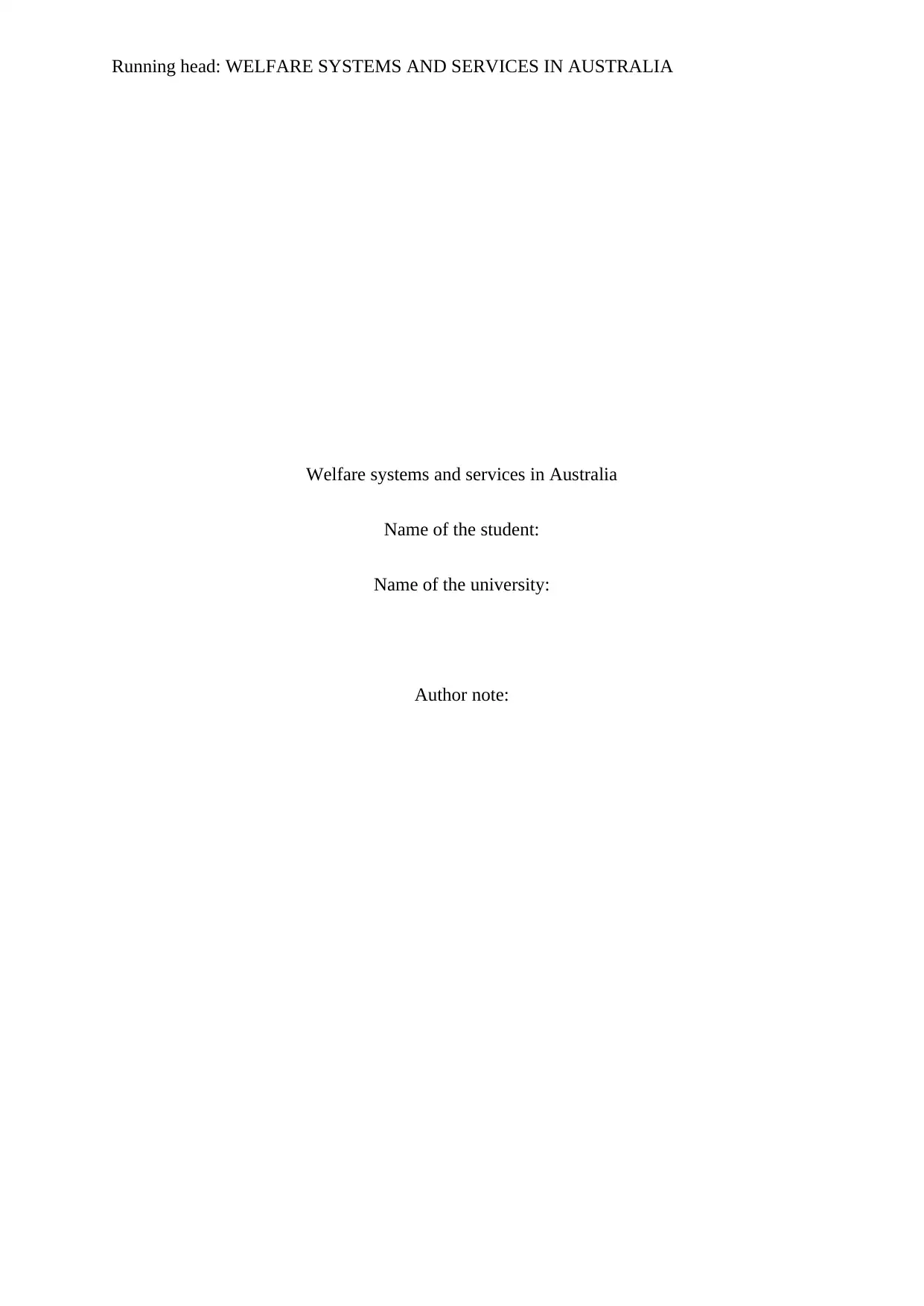
Running head: WELFARE SYSTEMS AND SERVICES IN AUSTRALIA
Welfare systems and services in Australia
Name of the student:
Name of the university:
Author note:
Welfare systems and services in Australia
Name of the student:
Name of the university:
Author note:
Paraphrase This Document
Need a fresh take? Get an instant paraphrase of this document with our AI Paraphraser
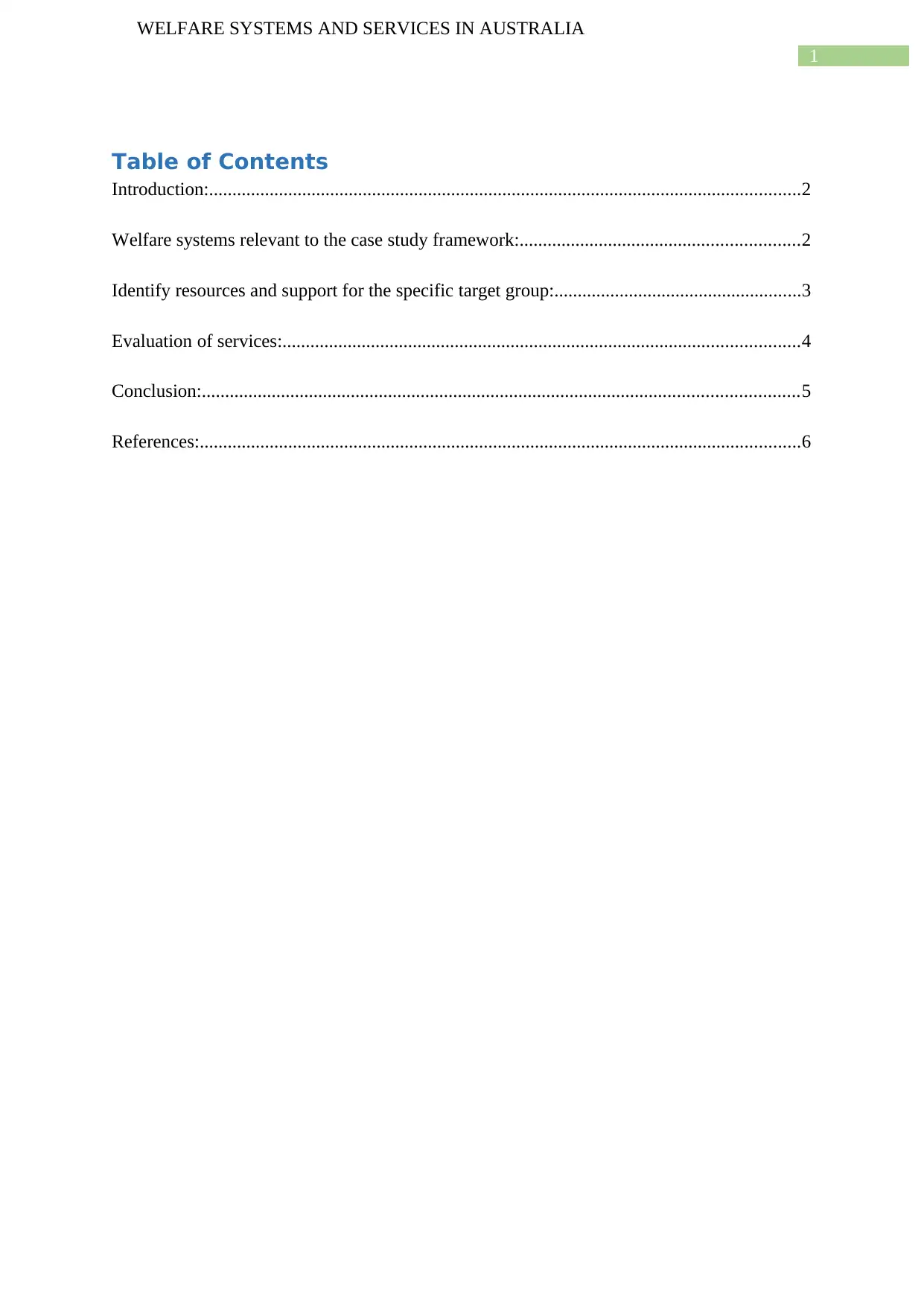
1
WELFARE SYSTEMS AND SERVICES IN AUSTRALIA
Table of Contents
Introduction:...............................................................................................................................2
Welfare systems relevant to the case study framework:............................................................2
Identify resources and support for the specific target group:.....................................................3
Evaluation of services:...............................................................................................................4
Conclusion:................................................................................................................................5
References:.................................................................................................................................6
WELFARE SYSTEMS AND SERVICES IN AUSTRALIA
Table of Contents
Introduction:...............................................................................................................................2
Welfare systems relevant to the case study framework:............................................................2
Identify resources and support for the specific target group:.....................................................3
Evaluation of services:...............................................................................................................4
Conclusion:................................................................................................................................5
References:.................................................................................................................................6
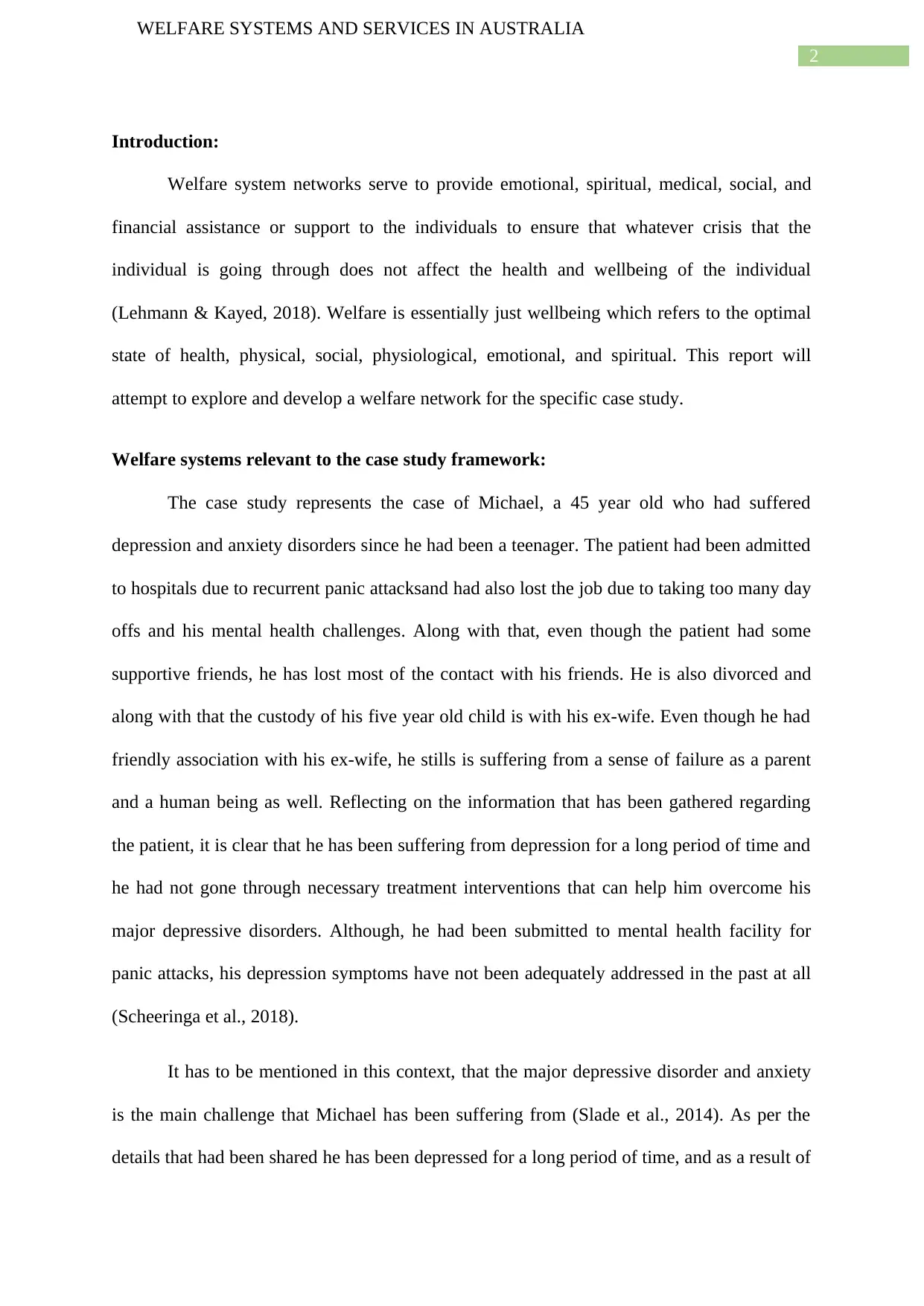
2
WELFARE SYSTEMS AND SERVICES IN AUSTRALIA
Introduction:
Welfare system networks serve to provide emotional, spiritual, medical, social, and
financial assistance or support to the individuals to ensure that whatever crisis that the
individual is going through does not affect the health and wellbeing of the individual
(Lehmann & Kayed, 2018). Welfare is essentially just wellbeing which refers to the optimal
state of health, physical, social, physiological, emotional, and spiritual. This report will
attempt to explore and develop a welfare network for the specific case study.
Welfare systems relevant to the case study framework:
The case study represents the case of Michael, a 45 year old who had suffered
depression and anxiety disorders since he had been a teenager. The patient had been admitted
to hospitals due to recurrent panic attacksand had also lost the job due to taking too many day
offs and his mental health challenges. Along with that, even though the patient had some
supportive friends, he has lost most of the contact with his friends. He is also divorced and
along with that the custody of his five year old child is with his ex-wife. Even though he had
friendly association with his ex-wife, he stills is suffering from a sense of failure as a parent
and a human being as well. Reflecting on the information that has been gathered regarding
the patient, it is clear that he has been suffering from depression for a long period of time and
he had not gone through necessary treatment interventions that can help him overcome his
major depressive disorders. Although, he had been submitted to mental health facility for
panic attacks, his depression symptoms have not been adequately addressed in the past at all
(Scheeringa et al., 2018).
It has to be mentioned in this context, that the major depressive disorder and anxiety
is the main challenge that Michael has been suffering from (Slade et al., 2014). As per the
details that had been shared he has been depressed for a long period of time, and as a result of
WELFARE SYSTEMS AND SERVICES IN AUSTRALIA
Introduction:
Welfare system networks serve to provide emotional, spiritual, medical, social, and
financial assistance or support to the individuals to ensure that whatever crisis that the
individual is going through does not affect the health and wellbeing of the individual
(Lehmann & Kayed, 2018). Welfare is essentially just wellbeing which refers to the optimal
state of health, physical, social, physiological, emotional, and spiritual. This report will
attempt to explore and develop a welfare network for the specific case study.
Welfare systems relevant to the case study framework:
The case study represents the case of Michael, a 45 year old who had suffered
depression and anxiety disorders since he had been a teenager. The patient had been admitted
to hospitals due to recurrent panic attacksand had also lost the job due to taking too many day
offs and his mental health challenges. Along with that, even though the patient had some
supportive friends, he has lost most of the contact with his friends. He is also divorced and
along with that the custody of his five year old child is with his ex-wife. Even though he had
friendly association with his ex-wife, he stills is suffering from a sense of failure as a parent
and a human being as well. Reflecting on the information that has been gathered regarding
the patient, it is clear that he has been suffering from depression for a long period of time and
he had not gone through necessary treatment interventions that can help him overcome his
major depressive disorders. Although, he had been submitted to mental health facility for
panic attacks, his depression symptoms have not been adequately addressed in the past at all
(Scheeringa et al., 2018).
It has to be mentioned in this context, that the major depressive disorder and anxiety
is the main challenge that Michael has been suffering from (Slade et al., 2014). As per the
details that had been shared he has been depressed for a long period of time, and as a result of
⊘ This is a preview!⊘
Do you want full access?
Subscribe today to unlock all pages.

Trusted by 1+ million students worldwide
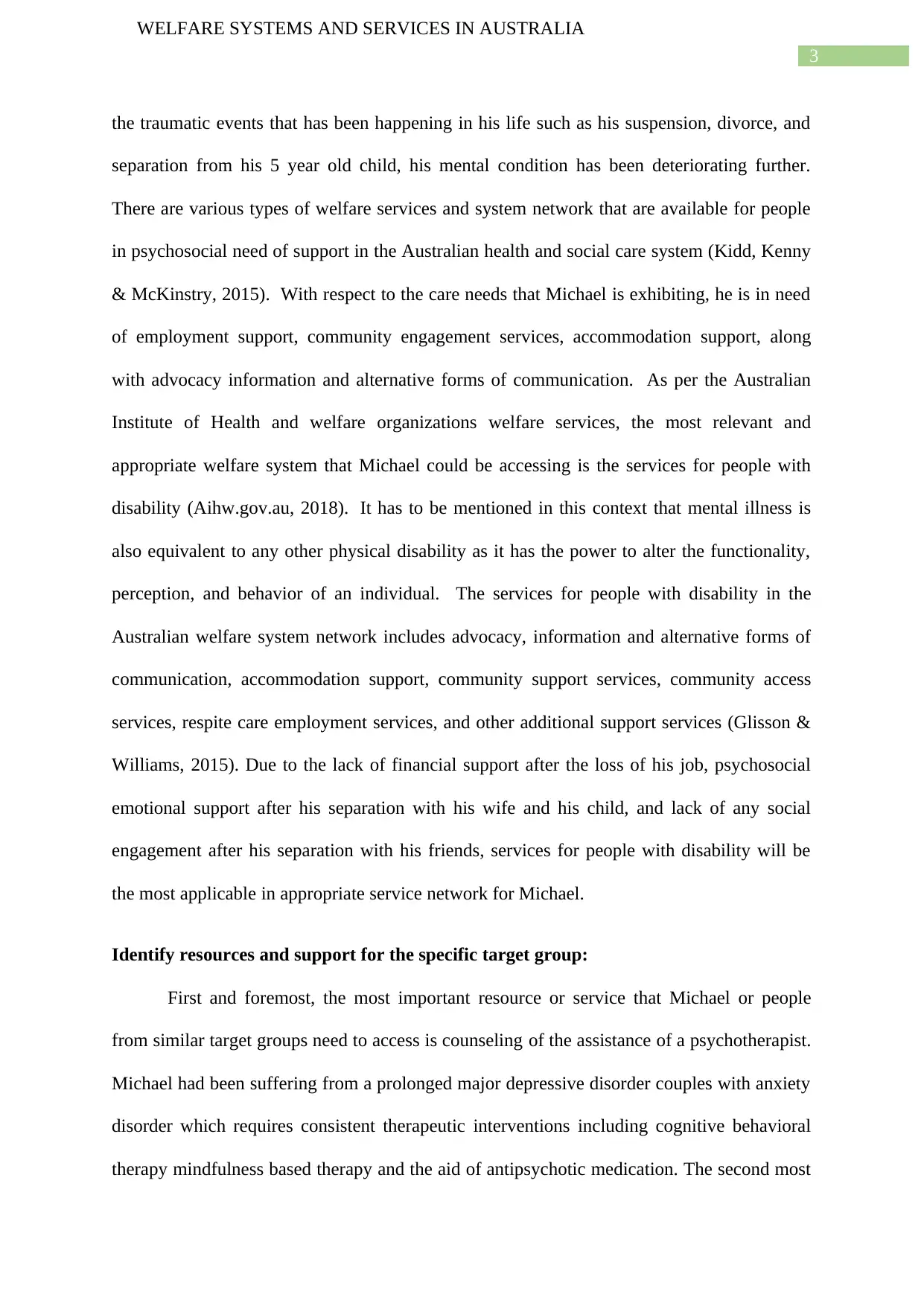
3
WELFARE SYSTEMS AND SERVICES IN AUSTRALIA
the traumatic events that has been happening in his life such as his suspension, divorce, and
separation from his 5 year old child, his mental condition has been deteriorating further.
There are various types of welfare services and system network that are available for people
in psychosocial need of support in the Australian health and social care system (Kidd, Kenny
& McKinstry, 2015). With respect to the care needs that Michael is exhibiting, he is in need
of employment support, community engagement services, accommodation support, along
with advocacy information and alternative forms of communication. As per the Australian
Institute of Health and welfare organizations welfare services, the most relevant and
appropriate welfare system that Michael could be accessing is the services for people with
disability (Aihw.gov.au, 2018). It has to be mentioned in this context that mental illness is
also equivalent to any other physical disability as it has the power to alter the functionality,
perception, and behavior of an individual. The services for people with disability in the
Australian welfare system network includes advocacy, information and alternative forms of
communication, accommodation support, community support services, community access
services, respite care employment services, and other additional support services (Glisson &
Williams, 2015). Due to the lack of financial support after the loss of his job, psychosocial
emotional support after his separation with his wife and his child, and lack of any social
engagement after his separation with his friends, services for people with disability will be
the most applicable in appropriate service network for Michael.
Identify resources and support for the specific target group:
First and foremost, the most important resource or service that Michael or people
from similar target groups need to access is counseling of the assistance of a psychotherapist.
Michael had been suffering from a prolonged major depressive disorder couples with anxiety
disorder which requires consistent therapeutic interventions including cognitive behavioral
therapy mindfulness based therapy and the aid of antipsychotic medication. The second most
WELFARE SYSTEMS AND SERVICES IN AUSTRALIA
the traumatic events that has been happening in his life such as his suspension, divorce, and
separation from his 5 year old child, his mental condition has been deteriorating further.
There are various types of welfare services and system network that are available for people
in psychosocial need of support in the Australian health and social care system (Kidd, Kenny
& McKinstry, 2015). With respect to the care needs that Michael is exhibiting, he is in need
of employment support, community engagement services, accommodation support, along
with advocacy information and alternative forms of communication. As per the Australian
Institute of Health and welfare organizations welfare services, the most relevant and
appropriate welfare system that Michael could be accessing is the services for people with
disability (Aihw.gov.au, 2018). It has to be mentioned in this context that mental illness is
also equivalent to any other physical disability as it has the power to alter the functionality,
perception, and behavior of an individual. The services for people with disability in the
Australian welfare system network includes advocacy, information and alternative forms of
communication, accommodation support, community support services, community access
services, respite care employment services, and other additional support services (Glisson &
Williams, 2015). Due to the lack of financial support after the loss of his job, psychosocial
emotional support after his separation with his wife and his child, and lack of any social
engagement after his separation with his friends, services for people with disability will be
the most applicable in appropriate service network for Michael.
Identify resources and support for the specific target group:
First and foremost, the most important resource or service that Michael or people
from similar target groups need to access is counseling of the assistance of a psychotherapist.
Michael had been suffering from a prolonged major depressive disorder couples with anxiety
disorder which requires consistent therapeutic interventions including cognitive behavioral
therapy mindfulness based therapy and the aid of antipsychotic medication. The second most
Paraphrase This Document
Need a fresh take? Get an instant paraphrase of this document with our AI Paraphraser
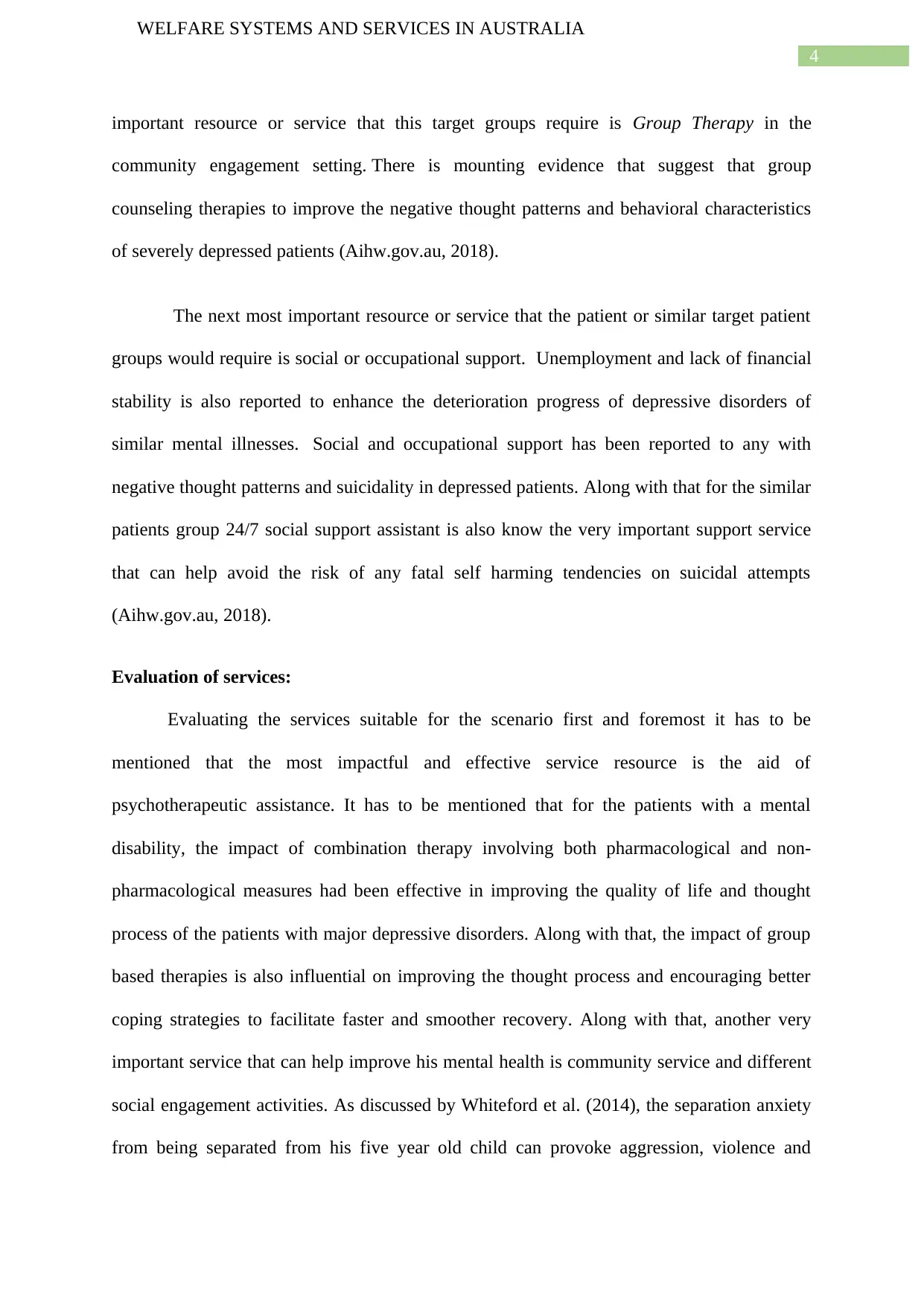
4
WELFARE SYSTEMS AND SERVICES IN AUSTRALIA
important resource or service that this target groups require is Group Therapy in the
community engagement setting. There is mounting evidence that suggest that group
counseling therapies to improve the negative thought patterns and behavioral characteristics
of severely depressed patients (Aihw.gov.au, 2018).
The next most important resource or service that the patient or similar target patient
groups would require is social or occupational support. Unemployment and lack of financial
stability is also reported to enhance the deterioration progress of depressive disorders of
similar mental illnesses. Social and occupational support has been reported to any with
negative thought patterns and suicidality in depressed patients. Along with that for the similar
patients group 24/7 social support assistant is also know the very important support service
that can help avoid the risk of any fatal self harming tendencies on suicidal attempts
(Aihw.gov.au, 2018).
Evaluation of services:
Evaluating the services suitable for the scenario first and foremost it has to be
mentioned that the most impactful and effective service resource is the aid of
psychotherapeutic assistance. It has to be mentioned that for the patients with a mental
disability, the impact of combination therapy involving both pharmacological and non-
pharmacological measures had been effective in improving the quality of life and thought
process of the patients with major depressive disorders. Along with that, the impact of group
based therapies is also influential on improving the thought process and encouraging better
coping strategies to facilitate faster and smoother recovery. Along with that, another very
important service that can help improve his mental health is community service and different
social engagement activities. As discussed by Whiteford et al. (2014), the separation anxiety
from being separated from his five year old child can provoke aggression, violence and
WELFARE SYSTEMS AND SERVICES IN AUSTRALIA
important resource or service that this target groups require is Group Therapy in the
community engagement setting. There is mounting evidence that suggest that group
counseling therapies to improve the negative thought patterns and behavioral characteristics
of severely depressed patients (Aihw.gov.au, 2018).
The next most important resource or service that the patient or similar target patient
groups would require is social or occupational support. Unemployment and lack of financial
stability is also reported to enhance the deterioration progress of depressive disorders of
similar mental illnesses. Social and occupational support has been reported to any with
negative thought patterns and suicidality in depressed patients. Along with that for the similar
patients group 24/7 social support assistant is also know the very important support service
that can help avoid the risk of any fatal self harming tendencies on suicidal attempts
(Aihw.gov.au, 2018).
Evaluation of services:
Evaluating the services suitable for the scenario first and foremost it has to be
mentioned that the most impactful and effective service resource is the aid of
psychotherapeutic assistance. It has to be mentioned that for the patients with a mental
disability, the impact of combination therapy involving both pharmacological and non-
pharmacological measures had been effective in improving the quality of life and thought
process of the patients with major depressive disorders. Along with that, the impact of group
based therapies is also influential on improving the thought process and encouraging better
coping strategies to facilitate faster and smoother recovery. Along with that, another very
important service that can help improve his mental health is community service and different
social engagement activities. As discussed by Whiteford et al. (2014), the separation anxiety
from being separated from his five year old child can provoke aggression, violence and
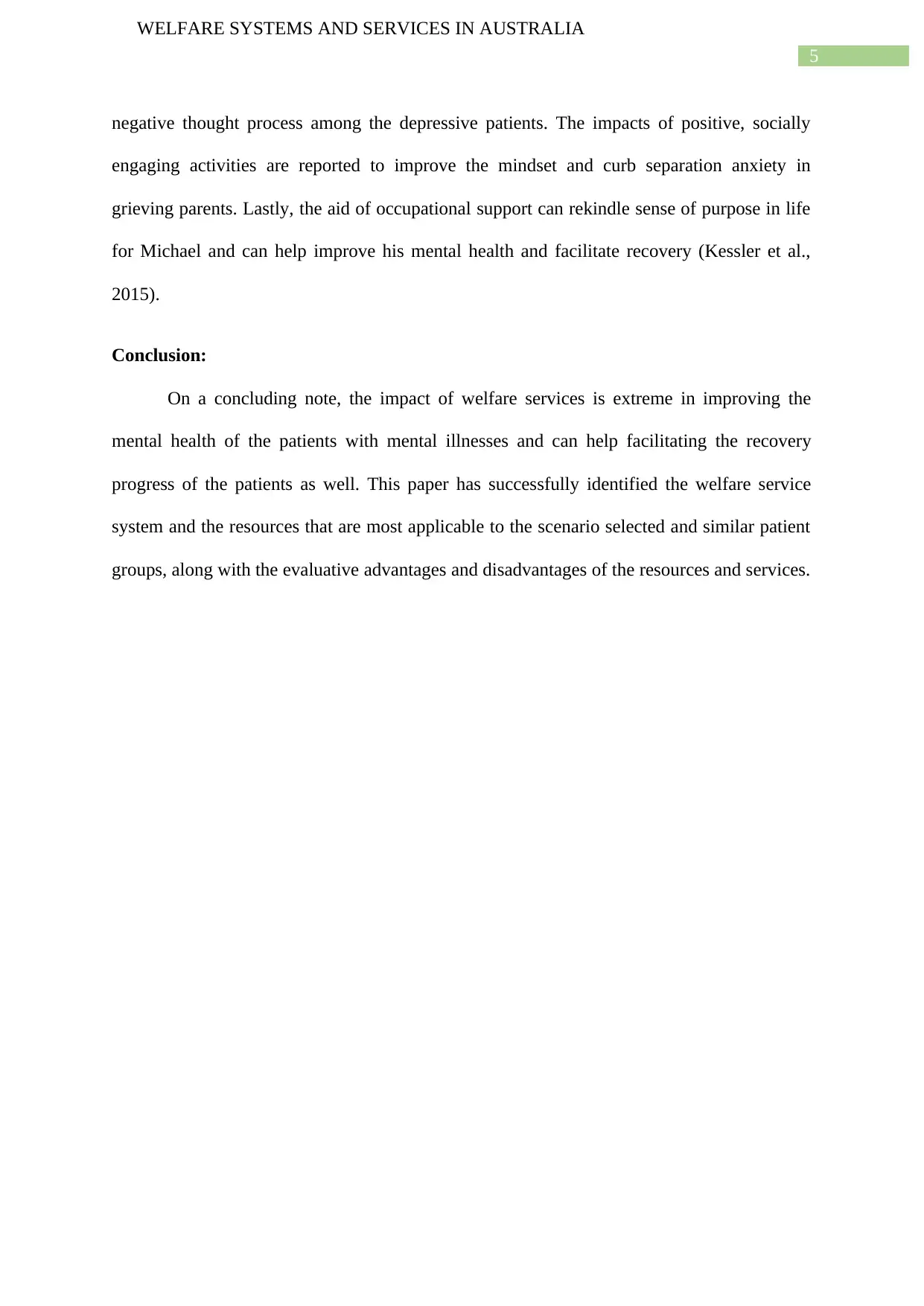
5
WELFARE SYSTEMS AND SERVICES IN AUSTRALIA
negative thought process among the depressive patients. The impacts of positive, socially
engaging activities are reported to improve the mindset and curb separation anxiety in
grieving parents. Lastly, the aid of occupational support can rekindle sense of purpose in life
for Michael and can help improve his mental health and facilitate recovery (Kessler et al.,
2015).
Conclusion:
On a concluding note, the impact of welfare services is extreme in improving the
mental health of the patients with mental illnesses and can help facilitating the recovery
progress of the patients as well. This paper has successfully identified the welfare service
system and the resources that are most applicable to the scenario selected and similar patient
groups, along with the evaluative advantages and disadvantages of the resources and services.
WELFARE SYSTEMS AND SERVICES IN AUSTRALIA
negative thought process among the depressive patients. The impacts of positive, socially
engaging activities are reported to improve the mindset and curb separation anxiety in
grieving parents. Lastly, the aid of occupational support can rekindle sense of purpose in life
for Michael and can help improve his mental health and facilitate recovery (Kessler et al.,
2015).
Conclusion:
On a concluding note, the impact of welfare services is extreme in improving the
mental health of the patients with mental illnesses and can help facilitating the recovery
progress of the patients as well. This paper has successfully identified the welfare service
system and the resources that are most applicable to the scenario selected and similar patient
groups, along with the evaluative advantages and disadvantages of the resources and services.
⊘ This is a preview!⊘
Do you want full access?
Subscribe today to unlock all pages.

Trusted by 1+ million students worldwide
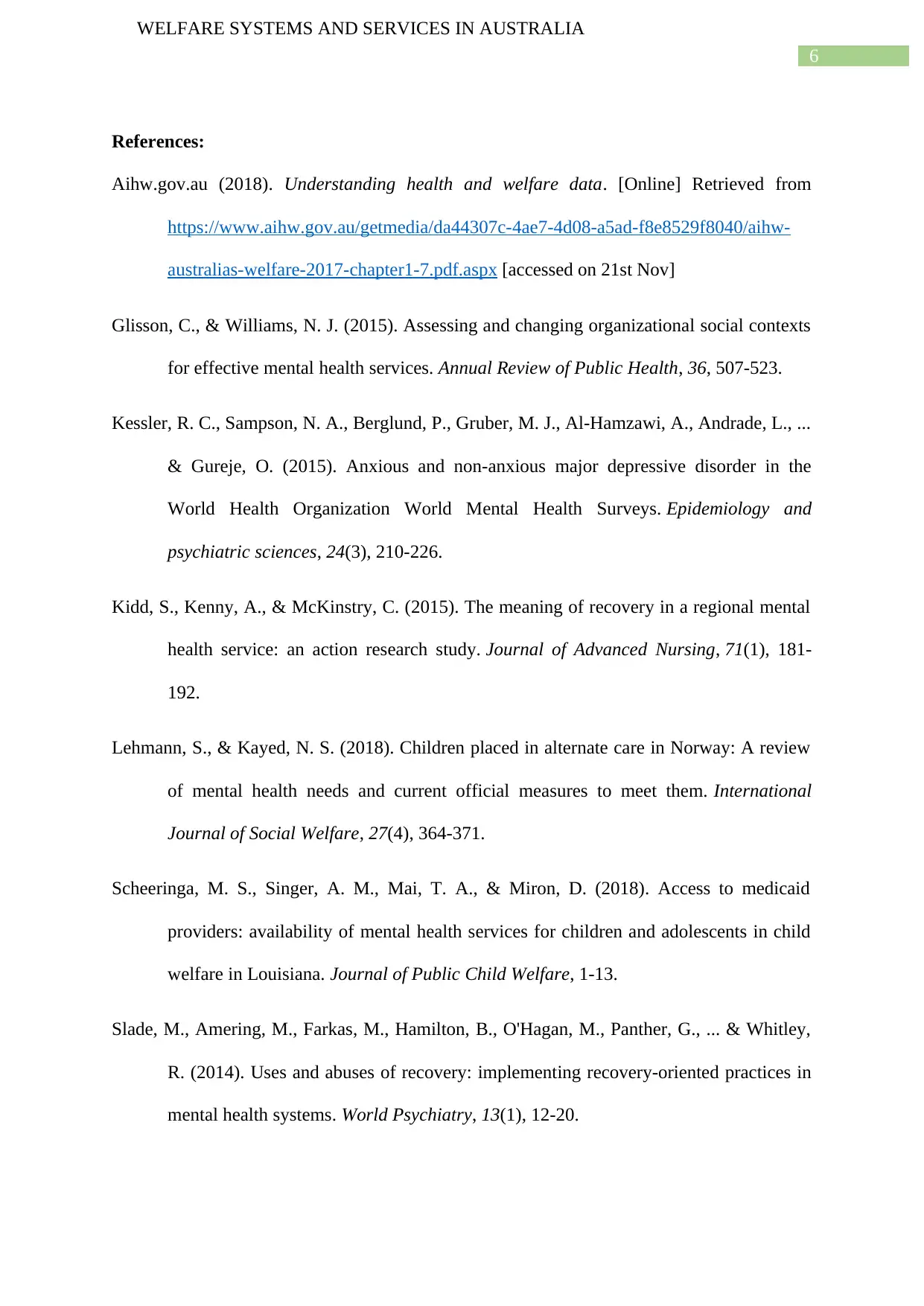
6
WELFARE SYSTEMS AND SERVICES IN AUSTRALIA
References:
Aihw.gov.au (2018). Understanding health and welfare data. [Online] Retrieved from
https://www.aihw.gov.au/getmedia/da44307c-4ae7-4d08-a5ad-f8e8529f8040/aihw-
australias-welfare-2017-chapter1-7.pdf.aspx [accessed on 21st Nov]
Glisson, C., & Williams, N. J. (2015). Assessing and changing organizational social contexts
for effective mental health services. Annual Review of Public Health, 36, 507-523.
Kessler, R. C., Sampson, N. A., Berglund, P., Gruber, M. J., Al-Hamzawi, A., Andrade, L., ...
& Gureje, O. (2015). Anxious and non-anxious major depressive disorder in the
World Health Organization World Mental Health Surveys. Epidemiology and
psychiatric sciences, 24(3), 210-226.
Kidd, S., Kenny, A., & McKinstry, C. (2015). The meaning of recovery in a regional mental
health service: an action research study. Journal of Advanced Nursing, 71(1), 181-
192.
Lehmann, S., & Kayed, N. S. (2018). Children placed in alternate care in Norway: A review
of mental health needs and current official measures to meet them. International
Journal of Social Welfare, 27(4), 364-371.
Scheeringa, M. S., Singer, A. M., Mai, T. A., & Miron, D. (2018). Access to medicaid
providers: availability of mental health services for children and adolescents in child
welfare in Louisiana. Journal of Public Child Welfare, 1-13.
Slade, M., Amering, M., Farkas, M., Hamilton, B., O'Hagan, M., Panther, G., ... & Whitley,
R. (2014). Uses and abuses of recovery: implementing recovery‐oriented practices in
mental health systems. World Psychiatry, 13(1), 12-20.
WELFARE SYSTEMS AND SERVICES IN AUSTRALIA
References:
Aihw.gov.au (2018). Understanding health and welfare data. [Online] Retrieved from
https://www.aihw.gov.au/getmedia/da44307c-4ae7-4d08-a5ad-f8e8529f8040/aihw-
australias-welfare-2017-chapter1-7.pdf.aspx [accessed on 21st Nov]
Glisson, C., & Williams, N. J. (2015). Assessing and changing organizational social contexts
for effective mental health services. Annual Review of Public Health, 36, 507-523.
Kessler, R. C., Sampson, N. A., Berglund, P., Gruber, M. J., Al-Hamzawi, A., Andrade, L., ...
& Gureje, O. (2015). Anxious and non-anxious major depressive disorder in the
World Health Organization World Mental Health Surveys. Epidemiology and
psychiatric sciences, 24(3), 210-226.
Kidd, S., Kenny, A., & McKinstry, C. (2015). The meaning of recovery in a regional mental
health service: an action research study. Journal of Advanced Nursing, 71(1), 181-
192.
Lehmann, S., & Kayed, N. S. (2018). Children placed in alternate care in Norway: A review
of mental health needs and current official measures to meet them. International
Journal of Social Welfare, 27(4), 364-371.
Scheeringa, M. S., Singer, A. M., Mai, T. A., & Miron, D. (2018). Access to medicaid
providers: availability of mental health services for children and adolescents in child
welfare in Louisiana. Journal of Public Child Welfare, 1-13.
Slade, M., Amering, M., Farkas, M., Hamilton, B., O'Hagan, M., Panther, G., ... & Whitley,
R. (2014). Uses and abuses of recovery: implementing recovery‐oriented practices in
mental health systems. World Psychiatry, 13(1), 12-20.
Paraphrase This Document
Need a fresh take? Get an instant paraphrase of this document with our AI Paraphraser
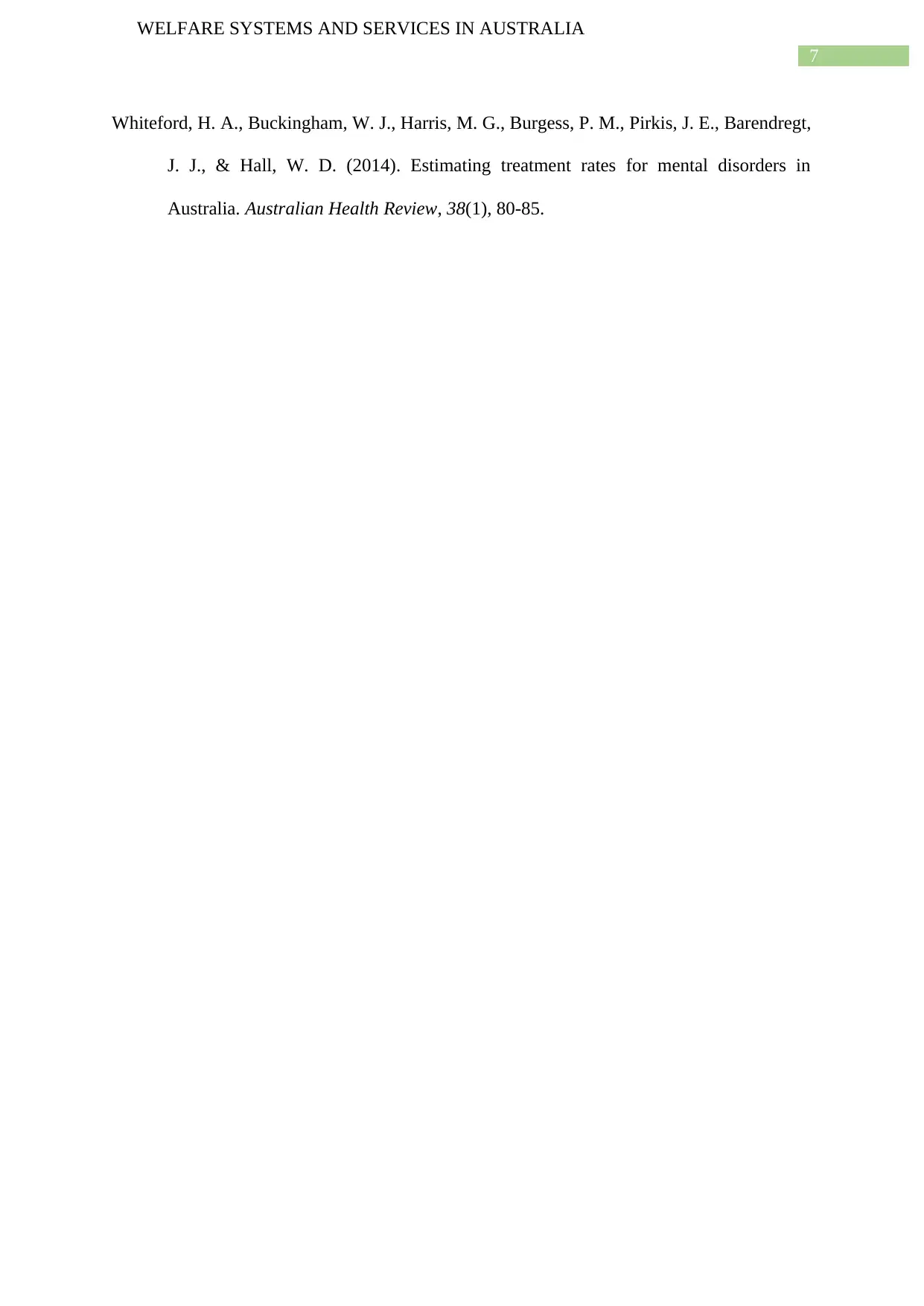
7
WELFARE SYSTEMS AND SERVICES IN AUSTRALIA
Whiteford, H. A., Buckingham, W. J., Harris, M. G., Burgess, P. M., Pirkis, J. E., Barendregt,
J. J., & Hall, W. D. (2014). Estimating treatment rates for mental disorders in
Australia. Australian Health Review, 38(1), 80-85.
WELFARE SYSTEMS AND SERVICES IN AUSTRALIA
Whiteford, H. A., Buckingham, W. J., Harris, M. G., Burgess, P. M., Pirkis, J. E., Barendregt,
J. J., & Hall, W. D. (2014). Estimating treatment rates for mental disorders in
Australia. Australian Health Review, 38(1), 80-85.
1 out of 8
Related Documents
Your All-in-One AI-Powered Toolkit for Academic Success.
+13062052269
info@desklib.com
Available 24*7 on WhatsApp / Email
![[object Object]](/_next/static/media/star-bottom.7253800d.svg)
Unlock your academic potential
Copyright © 2020–2025 A2Z Services. All Rights Reserved. Developed and managed by ZUCOL.





